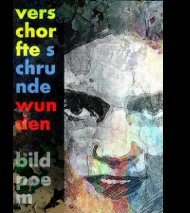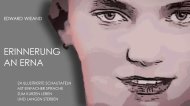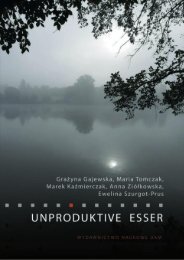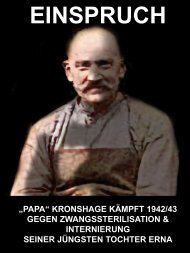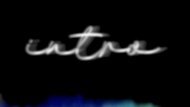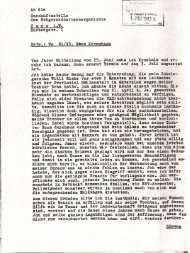ernabookXXL ENGLISH- 3.fass -
- No tags were found...
Create successful ePaper yourself
Turn your PDF publications into a flip-book with our unique Google optimized e-Paper software.
XXL<br />
A Nazi-‘‘euthanasia‘‘-victim:<br />
EDWARD WIEAND<br />
ERNA KRONSHAGE<br />
My laughter<br />
is crying<br />
IN PICTURES, DOCUMENTS AND FACTS<br />
english update| 06 | 2018 | 114 pages – DeepL Translator: german-english
2
Erna Kronshage – a Nazi-‘‘euthanasia‘‘-victim<br />
Erna Kronshage –<br />
Colored Photo-Portrait<br />
with original signature -<br />
around 1940<br />
3
4
SIGNPOST<br />
Where lies still lie<br />
like unburied corpses<br />
there is the way of truth<br />
not easy to spot<br />
and some are still reluctant<br />
or find him too dangerous<br />
The Truth Penetrates<br />
and at the same time sends their seekers<br />
back in history<br />
and begins to tidy up<br />
with the defamations<br />
and with the hush-up<br />
of the dead<br />
A lot will hurt<br />
make things awkward<br />
but the truth is<br />
the way of necessity<br />
if the realm of freedom is not restored<br />
should remain just an empty word<br />
and only a laughing stock<br />
for enemies and for the disappointed<br />
Erich Fried –<br />
translated with DeepL<br />
from German into English
Resumes have a long memory. Personal<br />
biographies as well as the common history. The<br />
experiences stored in them can be<br />
superimposed, hushed up, suppressed or<br />
hushed up in the course of time, but not<br />
undone.<br />
Remembering is more than just taking note.<br />
Those who remember or are remembered are<br />
reminded of events and experiences of<br />
personal and collective past, whether joyful or<br />
painful.<br />
The word says that remembering concerns us<br />
internally, it concerns us. Some remembrance<br />
requires courage and perseverance. Some<br />
remembrance is a duty imposed upon us by the<br />
will to justice and truthfulness towards guilt and<br />
failure....<br />
"Thinking about past matters," writes Hannah<br />
Arendt, "means for human beings to go into the<br />
dimension of the deep, to strike roots and thus<br />
to stabilize themselves so that one is not<br />
washed away by everything possible - the spirit<br />
of the age, history or simply the temptation.<br />
Dr. Hartmut Traub, Excerpt from the speech manuscript for<br />
the memorial service for the victims of Nazi "euthanasia" on<br />
27.01. 2017 in the German Bundestag
Childhood & School<br />
Class photo - ca. 1930-32 - Erna 2 row from top left (white arrow)<br />
7
The birthplace:<br />
The<br />
„Mühlenkamp“<br />
Senne II - a rural<br />
community near<br />
Bielefeld<br />
(Germany) –<br />
House No. 6<br />
Photo around 1940<br />
Die Verortung: Ernas Welt<br />
8
Erna was born 2 weeks before Christmas - on 12 December 1922 - in Senne II (today "Sennestadt").<br />
She is the 11th and youngest child - and is "educated", and certainly “betüddelt” and spoiled, primarily by the<br />
older siblings as nestling.<br />
The Kronshage family lives on this farm, which they also manage with joint forces - their father still works 9 halfday<br />
as a carpenter in a factory.
Entrance on the right - farmstead "Mühlenkamp"<br />
visible in the background<br />
Birthplace<br />
„Mühlenkamp“<br />
today<br />
Verler Straße 76 – 33689<br />
Bielefeld-Sennestadt<br />
10<br />
The house - renovated - today
„Mühlenkamp“<br />
Hof Westerwinter<br />
Erna Kronshages little world in<br />
Senne II – with the "Mühlenkamp" as centre<br />
of life... - on today's maps and aerial photos -<br />
Nearby is the former station "Kracks“ / today<br />
train stop “Sennestadt”<br />
11
A 33<br />
Erna Kronshages<br />
little world:<br />
Red grid square:<br />
corresponds to the<br />
"globe" - one page<br />
before...<br />
12
Typical landscape of the “Senne” until the 1950s.....<br />
This postcard motif shows the typical landscape of the "old" Senne - agricultural areas are streaked with small<br />
scattered spruce forests, heathland, sand dunes, sand depressions. Until the construction of the "Sennestadt" in the<br />
early 1960s, the Senne was sparsely populated - mostly with remote small farms........ Ernas Residence Senne II<br />
was a small rural community on sandy roads - south of Bielefeld. with approx. 2,500 inhabitants …<br />
13
Senne II - district "Kracks" - postcard from the 20s / 30s - the church and the inn Ramsbrock - bottom right - as village "Zentrum" 14<br />
(centre)
Senne II - excursion site on the southern slope of the Teutoburg Forest - with the former inn Ramsbrock - and the now crowded A2 motorway/Autobahn...<br />
15
On New Year's Day 1923, Erna is<br />
baptized Protestant-Lutheran in<br />
the church of Senne II by<br />
Pastor Jansen -<br />
and on 21.03.1937 (Sunday<br />
Palmarum) Erna Kronshage is<br />
confirmed in the church of<br />
Senne II by Pastor Holzapfel.<br />
The confirmation ruling was:<br />
"God is love; and he who abides in<br />
love abides in God and God in<br />
him." (1John, 4:16).<br />
16
Die Familie Kronshage ca. 1930<br />
The extended family Kronshage - photo around 1930<br />
Top row from left: - Johanne/“Hanna“ *1913, Martha *1911, Frieda *1909, Emma *1906, Lina *1903,<br />
Heini *1905, Willi *1917, Ewald *1919<br />
Bottom row from left: - ERNA *1922 (also image section bottom left), Anna *1902, Mama Anna<br />
*1879, Papa Adolf *1876, Adolf *1899 17
„In den Kugeln“ - In the bullets.- This painting by the painter Edgar Ende (1901-1965 - Father of the writer Michael Ende)<br />
was created in 1932 - and on the eve of the Nazi disaster, it symbolically shows the wind of the<br />
Industrial factory chimneys - and spherical cage globes around the doves of peace and around the spirit of man...-<br />
a thoroughly humid and hopeless atmosphere...
Adolf Hitler became Chancellor of the “Reich” in Germany in 1933.<br />
19
Planting a „Hitler oak“ at the square "Verler Dreieck" in Senne II - near the<br />
"Mühlenkamp" (see map) on May 1, 1933 - Erna is 10.5 years old - and is certainly<br />
one of them...<br />
Illustrating pictorial material
Erna attends the<br />
community school I in<br />
Senne II 1929 - 1937<br />
21
Illustrating pictorial material from the time:<br />
A classroom from 1935 ...<br />
22
Reproduction of the original school-leaving certificate for Erna Kronshage from 1937 - (grade cut 1.78) 23
Work as<br />
‘‘House<br />
daughter‘‘<br />
24
Erna Kronshage works at home after school as a “housedaughter<br />
in her parents‘ business”<br />
At that time, the profession of "house-daughter" was the<br />
professional title for a young woman who learned<br />
housework until marriage - an activity that was "usual"<br />
and widespread at that time.<br />
She lives in her family - for pocket money,<br />
accommodation, food and insurance - today this would<br />
probably mean: "au pair", which usually also includes<br />
childcare in the mostly foreign household.....<br />
Adolf Hitler says about the role of women in Nazi Germany in<br />
1934, among other things:<br />
“We do not consider it right for women to enter the world of<br />
men, into their main area, but we consider it natural for these<br />
two worlds to remain divorced. (...) What the man uses in<br />
heroism on the battlefield, the woman uses in eternally<br />
patient devotion, in eternally patient suffering and bearing.<br />
Every child she gives birth to is a battle she fights for the<br />
existence or otherwise of her people."<br />
Contemporary illustrative pictorial material<br />
25
Erna goes with the handcart to fetch the "streussel" (cowshed bedding).<br />
Erna and a little nephew...<br />
Erna Kronshage grows up to be an adult woman...<br />
26
The station "Kracks" - as it is still popularly<br />
known today (train stop "Sennestadt" - now<br />
demolished) - from the point of view of<br />
Kronshagen's fields<br />
27
illustrative visual material<br />
At the "Mühlenkamp", the bicycles of commuters who travel by train from "Kracks" station to work in the<br />
surrounding area are looked after from morning to evening... 28
Grammophone & radio "Volksempfänger" - plus the daily<br />
newspaper and a few magazines - these are the<br />
"entertainment media" of this time...<br />
Illustrating pictorial material 29
The Kronshage siblings were normal "teenagers" of their time:<br />
Ernas brother Willi plays the accordion at the Deelen door - and<br />
brother Ewald looks almost like a "James Dean" blend - Erna<br />
"adorns" herself with the military cap of one of her brothers.....<br />
30
But then - during the war the "Mühlenkamp" serves to "secure<br />
the food supply of the German people" in accordance with the<br />
Nazi regulations - which is why Erna Kronshage as "housedaughter"<br />
does not have to participate in other Nazi service<br />
obligations for the youth - but is also "obligated to serve"...<br />
The brothers are now soldiers, and the older sisters now have their own<br />
families. Erna is pretty much on her own - with her old parents.
Erna "fights" herself with the handcart for an oak tree in the yard:<br />
on the left of the bench seat we see the bicycles "parked" by the<br />
commuters from the station "Kracks" to Paderborn and Bielefeld...<br />
32
illustrative visual material<br />
The bomb trauma<br />
33
Illustrating pictorial material<br />
Out of the clear sky: On June 2, 1940, a lonely English airman bombed the Westerwinter<br />
estate on the opposite side of the road - 80 to 100 meters away from the Konshages...
Dieses Original-Foto<br />
zeigt das Ausmaß<br />
der Bombardierung …<br />
… eine junge Nachbarin ... a young Ernas neighbor kommt is dabei killed ums - Leben –<br />
ein junger a young Mann man dort there wird is seriously schwer injured verletzt - –<br />
die the Hofgebäude farm buildings liegen in ruins...<br />
Trümmern…<br />
This re-colored original photo<br />
shows the extent of the bombing<br />
of the neighbouring courtyard ...<br />
35
A nocturnal inferno -<br />
like out of the blue -<br />
It hadn't bombed before.<br />
in East Westphalia-Lippe...<br />
36
The bomb craters<br />
are about 80 - 120 m away<br />
from the “Mühlenkamp”:<br />
Circle of white: the "Mühlenkamp" - yellowish<br />
marked in the foreground: one of the bomb craters ...<br />
Translation of the press release from 04.06.1940:<br />
Original-Photo<br />
Bombs on a senne farmstead<br />
The sad heroic deed of a British aviator<br />
In the night to Sunday a British aviator dropped several<br />
bombs on the peaceful homestead Westerwinter in<br />
"Kracks", which hit and partially destroyed a residential<br />
house and an adjoining building. A young girl aged 22<br />
was killed and a young man seriously injured by a<br />
collapsing ceiling.
Ernas bomb trauma - out of the blue:<br />
White circles: the "Mühlenkamp" - the red dots mark the bomb impacts
I don’t want anymore - I can’t anymore... …<br />
39
In 1942 Erna Kronshage becomes sporadically unpunctual and<br />
resists - she rebels against her parents and refuses her<br />
cooperation - to which she is obliged.<br />
Erna no longer wants to live and work at home - she feels tired and weak and overwhelmed -<br />
and urgently needs a "break".<br />
Erna finds herself in a kind of "goal-closing panic" to miss her life and sees no development for<br />
herself.<br />
She longs for "smarter people" and for appropriate social contacts that correspond to her age<br />
and development...<br />
40
At that time, Ernas mother turned to the Nazi social worker, "Brown<br />
Sister" for short, because of Erna's unpunctuality and her disputes -<br />
because of the brown costume of the Nazi sisterhood, who as the<br />
"female elite troupe of the NSDAP" are to assess the respective<br />
situations with their knowledge of hereditary and racial care in order to<br />
report "behavioural abnormalities"...<br />
And this "brown sister", eager for duty, sees in Ernas' arbitrary<br />
dawdling real "behavioural abnormalities", for agriculture now has to<br />
serve the "securing the food supply of the German people" in the war,<br />
and only Ernas' unswerving duty there at home justified her exemption<br />
from other Nazi compulsory events...<br />
Erna Kronshage is therefore quoted for an examination by an official<br />
doctor (comparable today to the examination of her ability to work by<br />
the company doctor in the case of persistent unpunctuality at work...),<br />
during which she then even asks herself to be admitted to the<br />
provincial sanatorium in Gütersloh to become "fit" again - because she<br />
has already been spurred on by her sister Frieda, who was<br />
successfully restored there in only 4 weeks 3 years earlier after a "state<br />
of arousal", without any hereditary health consequences..<br />
Illustrating pictorial material:<br />
A young Brown Nazi Sister<br />
Erna now expects the same help so as not to disappoint her parents<br />
any further....<br />
And this initially confusing and seemingly naive desire to admit Ernas<br />
to this "sanatorium", which she probably literally understood in this way,<br />
is owed to the good experiences of Sister Frieda there...<br />
.<br />
41
Today’s explanations of the<br />
causes of sudden<br />
“insubordination” and<br />
refusals to work:<br />
• The progressive "loneliness" as formerly "betüddeltes" youngest child - as the "nest hook" of a 13-headed original family, which<br />
has now gradually shrunk to a 3-member micro-family due to war missions of the brothers and sisters and the accompanying<br />
departure of the older brothers and sisters from the parental home - with a big age and generation difference: Erna Kronshage<br />
is still under 20 years old - her parents are already 66 and 63 years old...).<br />
• The "moral dilemma": Erna Kronshage is torn between enjoying the nest warmth of the "Hotel Mama" on the one hand - and<br />
age-appropriate aspirations for departure, separation and independence on the other...<br />
• The trauma of war: the bombing of the neighbouring farm "out of the blue" - with the killing of a neighbour and the serious<br />
injuries of a young man there and the almost complete destruction of this neighbouring farm as a whole... - the turmoil of war in<br />
general - the fears for her 4 brothers at the front -<br />
• the air-raid alarm and the bombing of a nearby factory...<br />
• Summary of possible causes from today's perspective:<br />
• physically overtaxed / intellectually undertaxed<br />
• "unable to work" - needs a "time-out<br />
• "Zero buck" phase (puberty - adolescence)<br />
• Burn-out syndrome (physical overload)<br />
• Depressive mood (no prospects for the future - no patience of friends of the same age - loneliness)<br />
Post-traumatic stress disorder (bomb attack on neighbouring farm)<br />
• Fear Syndrome (Fear of War - Worrying about the Brothers at the Front)<br />
42
Erna wants to enforce this supposed "recreation"<br />
stay against the will of her parents, who have<br />
custody.<br />
And so, probably on the advice of the "brown<br />
sister", she makes "nails with heads" with a daring<br />
"trick"...<br />
To achieve this, she chats off her father's admission<br />
papers from the public health officer - and hands<br />
them over to a police patrolman who parks his<br />
patrol vehicle nearby by chance.<br />
In this way, she can undermine the consent of her<br />
parents, because now, accompanied by the now<br />
alarmed "Brown Sister", she spontaneously takes<br />
the initiative - under the keyword: "Danger in delay!"<br />
- as a "self and a person endangering the general<br />
public" - direct into the sanatorium in Gütersloh.<br />
Even if one is at first astonished about this "selfinstruction"<br />
- but Erna tries for the first time actively<br />
to take her person & health into her own hands -<br />
and asserts herself for the first time against the will<br />
of her parents...<br />
illustrative visual material
On 24.10.1942 Erna Kronshage arrives at the provincial-sanatorium<br />
Gütersloh<br />
- here are some contemporary postcards to illustrate the "culture shock" between such a "healing factory" in the spirit of Nazi<br />
psychiatry and - for comparison - the rural and peaceful ambience of the parental "Mühlenkamp" farm...
Provincial-sanatorium Gütersloh
A real "culture shock": e.g. the comparison of your<br />
sleeping chamber under the "roof-juchhe" at home<br />
with the dormitory in Gütersloh, which permanently<br />
smells of a mixture of sweat, vapours and sagrotan...<br />
... and then the bare and sterile hospital corridors, in<br />
which the voices of fellow patients echo...<br />
illustrative visual material<br />
46
Diagnosis: „Schizophrenia“<br />
47
Erna’s first diagnosis is schizophrenia...<br />
Upon arrival in Gütersloh, "schizophrenia" is surprisingly diagnosed, also due to the dawdling and the inexperienced<br />
flapsy of the defensive attitude in the admission interview - but also the ominous 4-week stay of sister Frieda in the<br />
sanatorium in 1939 is now given a new status in the family anamnesis by pedigree by the local Nazi psychiatrists - in<br />
contrast, all external possible re-active or age and developmental trigger mechanisms for Nena's behavioural disorders<br />
are simply ignored...<br />
At that time, schizophrenia was understood to be a mentally conditioned hereditary disease that can develop slowly or<br />
suddenly from within and without external causes.<br />
According to today's understanding, schizophrenia is associated with an<br />
• Loss of inner perception for what<br />
• Reality or<br />
• Dream or<br />
• fantasy is and<br />
• these different levels of time and realities flow into each other and intermingle.<br />
The possibilities and channels to perceive oneself, to approach others and the environment - to be there for others or to<br />
develop sympathies, to inspire oneself... -<br />
... have suddenly and irretrievably fallen apart and fragmented in a schizophrenia as in many small snippets and shards<br />
without a direct external cause...<br />
And schizophrenia already at that time differs explicitly from all the temporary, sometimes peculiar states that are<br />
"psycho-somatic", reflex-like without any action of their own, are physically triggered as protective-reactions when<br />
48<br />
external events present themselves as threatening or incisive for the soul...
Heredity (eugenics) was the "scientific" basis for exploring hereditary diseases - and was already taught in schools in<br />
contemporary display boards at the time - and formed the basic theory for training in health, social and medical helper<br />
professions.<br />
illustrative visual material<br />
49
By means of relevant diagrams, the theory of heredity was to be made accessible to the population...<br />
illustrative visual material<br />
50
The diagnosis "schizophrenia" was<br />
then "alternatively" "calculated"<br />
with the highly popular eugenics /<br />
heredity and a family related<br />
ancestor and clan table - often only<br />
with the slightest "deviations from<br />
the norm/conspicuousness" or in the<br />
generation sequence far back in time<br />
- and thus justified as "scientifically<br />
proven" triggering possibility....<br />
Especially the 4-week stay of Ernas<br />
sister Frieda in Gütersloh three years<br />
earlier now becomes Erna's "fate":<br />
the "temporary state of excitement"<br />
that was triggered at Frieda's<br />
workplace at that time now becomes<br />
a "psychopathic state of excitement"<br />
in retrospect in the pedigree.<br />
´- (Schizophrenia)" reinterpreted ...<br />
51
Erna’s sister Frieda was released after 4 weeks stay<br />
(25.02-25.03.1939) from the institution as cured:<br />
In Frieda's medical history, the following criteria<br />
are explicitly underlined on a routing slip:<br />
2. Discharge promising<br />
2. b) not toxic for reproduction<br />
2. c) capable of reproduction<br />
= so no hereditary disease !!!<br />
Handwritten was added - but not filled out:<br />
• form of the disease:<br />
• Prospects of recovery:<br />
• Report to medical officer:<br />
• Resubmission noted to 4.4.39 -<br />
• (but Frieda has already been released from the<br />
sanitarium) –<br />
• The confusing conceptualizations of the Nazi<br />
doctors in retrospect for this "temporary state of<br />
excitement" of Erna's sister Frieda in 1939 were<br />
then reinterpreted in Ernas' documents:<br />
• "as insanity in sanitarium treatment<br />
• "as Psychopathic state of excitation<br />
(schizophrenia)"<br />
• "as transient psychological disorders that have<br />
been interpreted as schizoid psychopathic<br />
excitement.“<br />
• But there is definitely no evidence of real<br />
schizophrenia by Frieda...<br />
52
This Schizophrenia therapy in the<br />
course of "more active medical<br />
treatment" (developed in 1929 by Dr.<br />
Simon, then director of the Gütersloh<br />
institution) was carried out in Gütersloh<br />
around 1940:<br />
"cardiazol shocks" for the artificial<br />
triggering of epileptic seizures (which<br />
later become known as electro-shocks) -<br />
and the "Work therapy" (e.g. gardening<br />
in the "work-crew", potato peeling<br />
kitchen, etc.)<br />
illustrative visual material<br />
Erna is sent off to work therapy to peel<br />
potatoes and to work in the nursery - but<br />
she already knows that from home.<br />
Therapies:<br />
cardiazole shocks<br />
occupational therapy<br />
53
Artificial epileptic seizures are triggered to reduce<br />
internal tension in people with schizophrenia.<br />
This was done in Gütersloh with "Cardiazol", which<br />
was injected into the arm bends.<br />
A bite roll of gauze is grafted between the teeth to<br />
protect against tongue bites in the cramp.<br />
First there are strong feelings of fear - and then the<br />
attack breaks out with convulsions, cramps and a<br />
deep unconsciousness.<br />
Afterwards Erna feels completely weak and<br />
confused and can hardly remember anything.<br />
After some series of seizures a panic fear of further<br />
shocks arises.<br />
"Cardiazol shocks" are therefore more a<br />
punishment than a "relaxation" in the everyday life<br />
of an institution...<br />
illustrative visual material<br />
54
A Cardiazole administration to trigger a seizure - here reproduced with illustrative and illustrative scene photos from<br />
a film...<br />
The Cardiazole is administered in a certain dose<br />
Injection of the cardiazole into the vein of the arm bends<br />
fixation<br />
illustrative visual material<br />
Experiencing the onset of the seizure phase as<br />
so-called “aura" with often inner horror images...<br />
55
1<br />
The feeling of the traumatically experienced<br />
"aura" passes over …<br />
2<br />
… into the seizure with gradual<br />
Loss of consciousness...<br />
un-off phases<br />
with epileptic<br />
seizure<br />
3<br />
A bite roll of gauze is grafted between the<br />
teeth to protect against tongue bites in the<br />
cramp.<br />
5<br />
cramps of all limbs - including the toes<br />
4<br />
Muscle stiffeners with<br />
Stretching and vibrating phases<br />
6<br />
56<br />
Wake-up phase - fixations due to subsequent confusion
"After Cardiazole treatment, a little quieter“…<br />
Entry in the physician's report of the treating psychiatrist in<br />
Gütersloh on "activating" medical therapy with<br />
Cardiazole cramps at Erna Kronshage<br />
"After the cardiazole treatment<br />
somewhat calmer" - and - "already<br />
after the one-time suspension of the<br />
treatment immediately restless,<br />
almost constantly in motoric<br />
movement" - at night - "loud senseless<br />
talking..., twitching with the hands<br />
and the head"...<br />
57
Consequences and side effects of<br />
cardialzol shock therapy<br />
The "inventor" Ladislaus of Meduna suggests "regularly<br />
triggering 30 strokes at three-day intervals" - an extreme<br />
physical and psychological burden. ...<br />
Intravenous injections of Cardiazol fight a torture with a<br />
different torture suffered by the patients as a death or<br />
end of the world experience. "Feelings of annihilation<br />
arise," states the specialist literature dryly. Often enough,<br />
Cardiazole shocks throw patients completely off course,<br />
who feel the injection "like an electric shock". Others<br />
experience "photisms" in the form of flashes of light and<br />
red vision, or "pain up to the outermost end of the body".<br />
Dr. Ernst Adolf Schmorl writes in 1938 in the "Allgemeine<br />
Zeitschrift für Psychiatrie und ihre Grenzgebiete" about<br />
the "influence of cardiazole cramp treatment on the<br />
clinical picture of psychoses" using the example of 130<br />
cases: In almost all of them he notes a "clear<br />
disinhibition" or even a "linguistic unleashing".<br />
Employment would be easier to manage. He claims to<br />
have noticed a "certain grace of movement", but also<br />
"fax syndromes" with a high degree of confusion.<br />
Schmorl wants to suggest that the antispasmodic is<br />
suitable for "immobilising", he always recommends<br />
individual "cardiazole strokes". From the doctors' point of<br />
view, this effect in particular makes martyrdom justifiable.<br />
illustrative visual material<br />
• "Throw a person with a behavioral disorder from the roof of<br />
a skyscraper and let them suffer the dying experience to<br />
the last possible point of intervention and catch them with<br />
a blanket just before the impact.<br />
• Praise this method as a therapy that has a quality of<br />
experience that changes people at least for a certain<br />
time... (see also the medical entries in the documents<br />
about Erna Kronshage's sometimes spontaneous<br />
"ridiculous and confused behavior").<br />
• Such "final" chemically triggered experience models<br />
certainly change the biochemical metabolism in the brain,<br />
i.e. the messenger substances in the neurotransmitters,<br />
which then naturally - positively or negatively - change the<br />
behavioral possibilities of the brain in the future.<br />
• The disciplinary aspect of most of these therapies,<br />
especially the painful and dangerous forced shock<br />
therapies, emerges from psychiatric self-reports.<br />
• Benedikt Fontana, Director of the Waldhaus Psychiatric<br />
Clinic in Chur, said in 1988 in retrospect of persistent<br />
prisoners in his institution:<br />
Source: Jürgen Schreiber: A painter from Germany - Gerhard Richter - Das Drama<br />
einer Familie, Berliner Taschenbuchg Verlag, 2007, pp. 95-96<br />
• “If they bucked,<br />
• we had to shock them.”<br />
58
A necessary note on Nazi psychiatry<br />
In order to more or less understand psychiatry in the Nazi era, the image of man and<br />
society that became internationally accepted in the 1930s on a "scientifically founded<br />
basis" must also be taken into account. Eugenics - the doctrine of race and heredity -<br />
was not only a German special "invention", but determined what was then, one might<br />
almost say, "global" psychiatry knowledge...<br />
In Germany it was the myth of the "Volksgemeinschaft" and a racist idealization of the<br />
so-called "Ariertum", as well as the striving for a "healthy body of the people", which<br />
can only actually be realized through exclusion and exclusion.<br />
According to this ideological program, the "sick", the so-called<br />
"Asocial" and "people with disabilities" selected, treated inhumanely and finally<br />
liquidated and murdered.<br />
Doctors, nurses, officials and numerous helpers carried the system of this "killing<br />
unworthy life" with them...<br />
Erna Kronshage knew little or nothing about these connections between war, time<br />
spirit, eugenics and Nazi ideology and the fatal consequences, including the murder<br />
of patients at the time of her wish to go to Gütersloh, or interpreted this as a rumour -<br />
or suppressed it in order to finally assert herself against her parents in their quest for<br />
independence?<br />
59
illustrative visual material<br />
elder<br />
Psychiatry Straitjacket<br />
60
illustrative visual material<br />
„Infertilization - Forced sterilization“
The Law for the<br />
Prevention of Hereditary<br />
Offspring<br />
was adopted shortly after the Nazi seizure of<br />
power on 14 July 1933 as the first race law<br />
in a long series of repressive measures and<br />
came into force in January 1934.<br />
The idea of the law was thoroughly racist:<br />
"The aim of the inheritance and race care<br />
appropriate to the German people is: a<br />
sufficient number of hereditary healthy, for<br />
the German people racially valuable families<br />
with many children at all times. The idea of<br />
breeding is the core content of the idea of<br />
race. The future legal guardians must be<br />
clear about the breeding goal of the German<br />
people."<br />
so the comment of Gütt, Rüdin, Ruttke in: Law for<br />
the Prevention of Hereditary Offspring of 14 July<br />
1933, Munich 1934<br />
Title Page of the Law Commentary
In 1934, the Nazis<br />
enacted the "Law for<br />
the Prevention of<br />
Young Offspring with<br />
Hereditary Diseases".<br />
At that time it was<br />
assumed that the<br />
children,<br />
grandchildren or<br />
great-grandchildren<br />
of these people<br />
could also be<br />
mentally ill or<br />
handicapped.<br />
However, this has<br />
since turned out to<br />
be untrue.<br />
Dr. Hartwich, then<br />
head of Gütersloh<br />
Hospital, thus<br />
applied for<br />
"infertility" for Erna<br />
Kronshage.<br />
Left: Reproduction of the<br />
original application for<br />
"sterilisation" from Gütersloh
Adolf Kronshage with his favourite cow<br />
Since Erna is not yet of<br />
age (then 21 years<br />
old), Ernas father still<br />
has full custody.<br />
He vehemently<br />
opposed Gütersloh's<br />
application and the<br />
court's decision to<br />
sterilize his daughter.<br />
At the same time, he<br />
repeatedly demands<br />
that Erna be released<br />
from the Gütersloh<br />
institution because he<br />
believes that Erna will<br />
recover most quickly at<br />
her home in the<br />
"Mühlenkamp".<br />
For this reason,<br />
extensive<br />
correspondence<br />
developed between the<br />
institution, the<br />
"hereditary health<br />
courts" and the father<br />
of Erna.<br />
Despite his poor<br />
health, he fights<br />
vehemently for his<br />
daughter - and forces<br />
with his objections that<br />
at least two courts must<br />
process the application<br />
one after the other...<br />
to the right: Excerpts from the<br />
protest letters and resistance<br />
submissions of the father to the<br />
institution and the inheritance<br />
health courts.<br />
64
illustrative visual material<br />
On March 29, 1943, a judge and two<br />
psychiatrists sit at the table at Heil-Anstalt<br />
Gütersloh. They form the Bielefeld<br />
Hereditary Health Court and decide every<br />
20 minutes on the sterilization of a total of<br />
11 patients. Erna Kronshage is "presented"<br />
there as the third "case" from 8.40 a.m. to<br />
9.00 a.m.: without lawyer or help this last<br />
measure is decided.........<br />
Erna laughs with excitement and<br />
embarrassment at the hearing. To the<br />
question of the gentlemen why she laughs,<br />
she answers recklessly with the actually<br />
deep sentence:<br />
"My laughter is crying".........<br />
The minutes of the meeting then read:<br />
"Erna Kronshage made a tense<br />
impression at the hearing and<br />
laughed for no reason. She said<br />
that her laughter was crying” ...<br />
And this behavior is now pathologically<br />
interpreted in order to underline once again<br />
the "schizophrenia" questioned by Ernas<br />
father.<br />
But 20-year-old Erna laughs so as not to<br />
cry, for she would be ashamed of these<br />
men - to whom she is alone........<br />
65
Reproduction of the original decision to sterilise the Hereditary Health Court of Bielefeld as the<br />
first instance<br />
66
Reproduction of the original decision to sterilise the Hereditary Health High Court in Hamm as<br />
second instance<br />
67
The "hereditary strains" that lead to Erna Kronshages diagnosis of "schizophrenia" and<br />
thus to "infertility" through forced sterilization...<br />
Schizophrenia is defined as an "endogenous" event - i.e. occurring suddenly or slowly from within - and not "exogenously" - as a reaction to<br />
"external events"... - and consequently - according to the opinion of the time - there must also be a high genetically determined trigger<br />
mechanism in the "genome" for this...<br />
In the Erna Kronshage case, the Provinzialheilanstalt Gütersloh submitted the following information to the Hereditary Health Court in<br />
Bielefeld: 1. from the medical report on infertility:<br />
One of the father's<br />
sisters was in hospital<br />
for pregnancy psychosis.<br />
An older sister of the<br />
patients was in hospital<br />
treatment for mental<br />
illness.<br />
The "mental illness" named by the "older sister" Frieda is described very differently in the further course of the hereditary health file:<br />
• 2. entry from the "hereditary family tree": (the diagnostic suffix "schizophrenia" was added to Sister Frieda only upon<br />
application for Erna Kronshage...)<br />
(...) Gütersloh<br />
Sanatorium 25.2.39 to<br />
25.3.1939 due to<br />
psychopathic arousal<br />
(schizophrenia)<br />
•<br />
• 3. Friedas "schizophrenia" becomes a "schizoid psychopathic state of excitement" again from the decision to infertility in the<br />
2nd instance at the "Erbgesundheitsobergericht" Hamm - which was successfully treated in 4 weeks..:<br />
... temporary mental<br />
disorders have<br />
occurred that have<br />
been interpreted as<br />
schizoid psychopathic<br />
arousal.<br />
68
illustrative visual material<br />
The execution of forced sterilization<br />
69
illustrative visual material<br />
The father's objections are of no use:<br />
The Hereditary Health High Court in<br />
Hamm finally decides that Erna is<br />
operated on by a Dr. Stüwe on August 4,<br />
1943 in the hospital in Gütersloh and<br />
thus made "infertile".<br />
In the "Medical Report" (left) it says<br />
succinctly: "The wound healed in 7 days<br />
without side effects"...<br />
70
Deportation<br />
71<br />
illustrative visual material
illustrative visual material<br />
The bomb war and the front-line operation cause more and more deaths and serious injuries.<br />
Hospitals and hospitals are therefore overcrowded - and from 1943 onwards people are<br />
urgently looking for beds to treat the many injured. 72
Prof. Dr. Karl Brandt, Begleitarzt<br />
Adolf Hitlers<br />
Overcrowded spare hospital in a gym<br />
"The thought that a war wounded<br />
man has no bed because there is<br />
already a mentally ill man in it is<br />
unbearable for Hitler" –<br />
Prof. Dr. Karl Brandt,<br />
Adolf Hitler's personal physician and<br />
Reich Commissioner for the Health<br />
Service<br />
writes Manfred Vasold 2007 in the<br />
"Encyclopedia of National Socialism".<br />
73
Erna's father Adolf Kronshage has repeatedly demanded in the meantime that Erna be released from the<br />
institution, and this could have also formally happened after forced sterilization: Meanwhile, however, there are<br />
instructions from the Reich Ministry of the Interior - quote: "Prisoners who were ordered to the institution by<br />
the police can no longer be released home because these "mentally unstable persons in air-raid<br />
shelters... can very easily lead to disputes...". Therefore the "dismissal must be rejected"...<br />
Erna Kronshage is inevitably trapped...<br />
At the same time, in the course of the so-called "Aktion Brandt", beds are to be cleared in the psychiatric facilities<br />
for the acutely necessary care and nursing of bomb victims and war wounded - i.e. for general hospital and<br />
hospital needs.<br />
The guidelines and guidelines were handed over directly and centrally from Berlin to the individual nursing homes<br />
by the planners under the personal physician Dr. Karl Brandt, appointed by Hitler in 1943, as head of the entire<br />
medical care system and coordinator of medical research.<br />
There it was determined where and how much capacity should be redistributed accordingly - and according to<br />
which selection criteria this should be done - see the "secret" letter on the assignment of patients to the respective<br />
"service groups".<br />
Recent studies show that, at least in Gütersloh, it was perhaps not so much these service groups or "behaviours"<br />
or "sanctions" towards individual patients that were taken into account when drawing up the transport lists, but<br />
rather the need to vacate apparently suitable residential areas in the area of the facility.<br />
To what extent this deportation transport was communicated with the survivors on 12.11.1943 is not known...<br />
74
Such "secret" orders also reached Gütersloh<br />
illustrative visual material<br />
Deportation: Implementation instructions in accordance with the (special) action Brandt: The medical institutions are partly evacuated in order to get free<br />
places to care for civilian and uniformed war wounded by providing and converting them into military and civil hospital beds: And in this displacement process<br />
the psychiatric patients in question are systematically named locally on a decentralized basis and "hunted down" with the deportation...<br />
For this purpose there were "secret" implementation orders (see the two original letters above) to the individual hospitals involved. Thus, the patients to be<br />
separated should be assessed according to service groups: who is still useful and who is a "useless eater". Then, as a rule, the deportation groups were put<br />
together.
Illustrating pictorial material:<br />
The" Grey Buses" -<br />
here for the trips of<br />
Institution to the railway station ...<br />
All deportation transports are carried out by the GEKRAT (alias: "Gemeinnützige Krankentransportgesellschaft"): a Berlin Nazi<br />
organization that precisely coordinates this carriage driving to death despite war and air raids...
illustrative visual material<br />
Erna Kronshage is deported on 12.11.1943 with 99 fellow patients.<br />
The transport leads via Hanover and Berlin to German-occupied<br />
Poland - to the "Tiegenhof", 630 km away - near the city of Gnesen. 77
From now on it's finally downhill: Erna Kronshage is part of the evacuation deportation to Gnesen<br />
on November 12, 1943: about 630 kilometers...<br />
illustrative visual material<br />
78
People become piece goods:<br />
Demonstration photo montage<br />
The deportation patients are marked with leukoplast strips between the shoulder blades,<br />
which cannot be manipulatively removed.<br />
79
Foto: nach imagenes.4ever.eu<br />
80
illustrative visual material<br />
Nazi euthanasia.<br />
annihilation<br />
81
illustrative visual material<br />
The historian Götz Aly<br />
has calculated:<br />
Approximately one in<br />
eight adult Germans is<br />
directly related to<br />
someone who was the<br />
victim of Nazi sick<br />
murders.<br />
And if you add the<br />
married relatives,<br />
almost everyone would<br />
find someone in the<br />
families.<br />
… jeder 8.<br />
erwachsene<br />
Deutsche …<br />
Most families didn't talk<br />
about it.<br />
The murdered are<br />
forgotten.<br />
Source: SPIEGEL<br />
discussion of 22 April<br />
2013<br />
Every 8th adult German …<br />
82
If only one minute's silence were allowed for each of the approximately 300,000 victims of the<br />
various "euthanasia" phases, it would be 5,000 hours of silence - well over half a year (0.57<br />
years) or almost 30 weeks (29.76 weeks) or 208 days (208.333 days).<br />
83
Nazi euthanasia-<br />
PHASES 1939 - 1945<br />
"Children's Euthanasia" 1939-1945<br />
approx. 8,000 victims (handicapped children)<br />
in approx. 40 "children's departments".<br />
Killing type: different<br />
"Action T 4" 1940-24.08.1941<br />
at least 70,243 victims (centrally controlled)<br />
6 killing facilities<br />
Killing type: Gas<br />
„Action 14f13" 1941-1944<br />
approx. 20,000-30,000 victims<br />
(concentration camp prisoners)<br />
various killer sites<br />
Killing type: different<br />
Prof. Dr. Karl Brandt,<br />
Adolf Hitler's accompanying surgical physician, SS<br />
Group Leader and Lieutenant General of the<br />
Waffen SS as well as Commissioner General for<br />
Medical and Health Services, has been entrusted<br />
by Hitler with the implementation and coordination<br />
of the actions...<br />
illustrative visual material<br />
"Wild Euthanasia"/"Decentralized Adult Sicricides" 1940-<br />
1945<br />
approx. 80,000 -120.000 victims (psychiatry and nursing<br />
homes)<br />
various killer sites<br />
Killing type: different<br />
"Action Brandt" 1943-1945<br />
Evacuation of sanatoriums to the facility<br />
of hospital beds for the war-disabled<br />
"Air War Evacuation„<br />
approx. 30,000-45,000 victims (psychiatry and nursing homes)<br />
various killer sites<br />
Killing type: „‘Luminal‘ scheme": reduced-calorie diet with slight<br />
barbiturate overdose
Mentally handicapped and Psychiatric patients<br />
are "useless eaters" for the Nazis, who only cost<br />
money - but bring nothing - which impair the<br />
"healthy body of the people".<br />
From 1939 Hitler pursued a simple and quick "solution" and<br />
gave the order to kill these people "by grace", "to redeem"<br />
them.<br />
A questionnaire is used to select the people for these murders<br />
of the sick by doctors:<br />
There are three things at stake here:<br />
• Who's the sick one?<br />
• How severe is the disease or disability?<br />
• Can and will he work?<br />
In 1941, the first phase of centralized murder is interrupted<br />
after a total of more than 70,000 murder victims ("T4"<br />
campaign) due to interventions by isolated church people.<br />
From the end of 1942, the "euthanasia" murders continued -<br />
but now behind closed doors: with the support of the "T4"<br />
organizations in Berlin, each sanatorium determined - for<br />
various reasons - which patients as death candidates were<br />
transferred to a killing sanatorium by special train. There are<br />
mass murders with sleeping pills and starvation. Only simple<br />
water soups are served, without nutrients, and dry bread with<br />
Pell potatoes as topping.<br />
At least 1,017 patients will also be deported from the<br />
Gütersloh sanatorium.<br />
85
Protests by churches through petitions, letters and sermons –<br />
by intervention of the churches, the centrally controlled "T4" sick murders in 1941 are first stopped - but then from 1942/43<br />
on, organized locally and continued on a large scale and in various phases of the process with the help of the central rope<br />
teams from Tiergartenstraße 4...<br />
Pastor Paul-Gerhard Braune,<br />
head of Lobetal in the v.<br />
Bodelschwingh Institutions -<br />
His fight against "euthanasia" is<br />
regarded as an important act of<br />
Protestant resistance under<br />
National Socialism. He<br />
succeeded in preventing the<br />
evacuation of the inhabitants of<br />
the Hoffnungstaler Anstalten.<br />
This fight against "euthanasia" and the conquest of the<br />
Inner Mission led to his imprisonment by the Gestapo on<br />
August 12, 1940. He was detained for three months in the<br />
Gestapo prison in Prinz-Albrecht-Straße in Berlin.<br />
In 1943 Braune stood up for arrested homosexual<br />
inhabitants of the Hoffnungstaler Anstalten and wrote,<br />
unsuccessfully, petitions for mercy for those condemned<br />
to death.<br />
Bishop Count von Galen, Münster –<br />
sermon from the pulpit that now also in the<br />
province of Westphalia sick people are<br />
being removed from sanatoria and nursing<br />
homes and the relatives were informed<br />
after a short time that the sick person had<br />
died and the body had already been<br />
cremated. He had the "suspicion,<br />
bordering on security, that one follows the<br />
doctrine that "one may destroy so-called<br />
life unworthy of life". ... "Poor people, sick people, unproductive<br />
people because of me! But did they forfeit their right to life? Do<br />
you, I only have the right to live as long as we are productive, as<br />
long as we are accepted as productive by others?"<br />
The sermons were initially spread throughout Germany - mostly<br />
by typewriting - within small Catholic groups, but very soon<br />
reached a wider public via workplaces and air-raid shelters.<br />
In particular, the killing of war invalids, which the bishop only<br />
described in subjunctive language as a possible consequence,<br />
was taken up as an assertion of facts and considerably intensified<br />
the effect of the sermons.<br />
Since those in power came to the conclusion that secrecy in the<br />
killing of the sick had failed and "euthanasia" had proved to be<br />
unacceptable among large sections of the population, Action T4<br />
was interrupted and only continued in a less conspicuous form a<br />
year later.<br />
illustrative visual material
from the cover picture of the DVD cover of the film "Tiegenhof", 2011
Gauheilanstalt Tiegenhof near Gnesen - in<br />
occupied Poland<br />
Name before and after the German occupation: Dziekanka/Gniezno<br />
Aerial view - bottom left: Typical pavilion - top right: Main house on a book cover for<br />
the 100th birthday 1994<br />
illustrative visual material<br />
88
illustrative visual material<br />
Above the pavilion roofs of Tiegenhof
illustrative visual material<br />
Above the pavilion roofs of Tiegenhof - in the background the silhouette of Gnesen/Gniezno
Block 13 in the Gauheilanstalt "Tiegenhof" in Gnesen - equipment for a Polish documentary -<br />
Photo: Martyr Museum in Zabikowo from the film "Tiegenhof - - 2011 (Film – click here)<br />
91
The Tiegenhof/Gnesen institution as a destination for deportation transport has<br />
developed into a killing centre under the direction of Dr. Victor Ratka since<br />
1939:<br />
• From the end of 1939 to the beginning of 1945 - in a good 5.5 years -<br />
almost 3,600 people were killed in "Tiegenhof/Dziekanka" according to<br />
publications of the current clinic management - i.e. about 700 people per<br />
year –<br />
• that is an average of almost 2 deaths per day in an institution with an<br />
occupancy rate of just over 1,000 patients from about 1943...<br />
• this corresponded to an average mortality rate of at least 70 % per year.<br />
• Especially in "Dziekanka" before the Nazi era, "normal" was a mortality rate<br />
of only 1 to 2 % per year.<br />
• From the end of 1939 to 1941, more than 1,000 Polish inmates were initially<br />
murdered in Dziekanka - partly in converted small trucks as gas wagons in<br />
which the exhaust gases were diverted to the loading area with the<br />
"passengers"... (“SS Special Command Herbert Lange”)<br />
• The latest research on Dziekanka/Tiegenhof assumes that 5,000 or more<br />
sick-killers have been killed...<br />
92
illustrative visual material<br />
93<br />
Dying Room, memorial plaque for the "Euthanasia" victims (1948),<br />
Entrance Women's Pavilion
Still from the film "Tiegenhof", 2011<br />
94
95<br />
According to testimonies of witnesses in the post-war period, violent attacks also took place in Tiegenhof.<br />
Administering the deadly drugs by the nursing staff... - Illustrating pictorial material
e.g. a fatless vegetable soup<br />
result in the "yellow soup" as<br />
creeping poison ...<br />
+ dissolved sleeping pills<br />
The mass killings of deportation patients from the "Reichsgebiet" from about the end of 1941 to the beginning of 1945<br />
mostly take place according to Prof. Dr. Hermann Paul Nitsche's "Luminal Scheme" - which he first "scientifically" tests on<br />
60 patients and then gradually refines and develops - and which he offers to the Nazi "euthanasia" directors of institution<br />
for the decentralized/"wild" actions from August 1943 - after the first killing action "T4" discontinued in 1941:<br />
The Luminal scheme consists of a so-called hunger diet with "yellow soup" = the administration of fatless food with<br />
dissolved sleeping pills (barbiturates - e.g. Luminal) in only a slightly increased dose = so that death only occurs after<br />
weeks or months. This death is then ultimately a creeping poisoning syndrome in the immune system weakened by hunger<br />
food - specifically, infections such as pneumonia or bronchitis are the "official“ "natural" causes of death - or simply a<br />
"complete exhaustion of the body" as with Erna Kronshage - without any external traces of violence - an almost "perfect"<br />
murder....<br />
96
Erna Kronshage is killed on 20.02.1944 in Tiegenhof/Gnesen.<br />
It takes exactly 100 days from the day they arrive from Gütersloh until they are<br />
murdered...<br />
Illustrating pictorial material<br />
97
Dr. Victor Ratka - Director Tiegenhof<br />
& T4 expert<br />
• born on 27.11.1895 Ober-Lazisk - + 05.04.1966 Heitersheim), late<br />
recognized Volksdeutscher as Upper Silesian and director of a Polish<br />
"sanatorium";<br />
• From 1918-1921 he studied medicine at the Albert-Ludwigs-University in<br />
Freiburg;<br />
• Preliminary medical examinations 1918-1921 (Archive: B 73/51);<br />
• Doctoral certificate of 01.10.1922 (Archive of the University of Freiburg under<br />
D 11/83, D 29/27/1427);<br />
• Ratka conducted studies within the framework of the David Julius Wetterhan<br />
Foundation*) from 1917-1922 (Archive: B 1/619) ...<br />
• ) .... in addition - from messages of the Jewish community of the city of<br />
Freiburg/Breisgau: The private man David Julius Wetterhan from Frankfurt a.<br />
M., who died here in September 1914, had established a foundation of<br />
168,000 marks in his will at the University of Freiburg to promote natural<br />
history and medical studies".<br />
• In 1928 Ratka became senior physician of the Lublinitz institution;<br />
• From 1934 director of DZIEKANKA institution in Gniezno/Gnesen (named<br />
"Tiegenhof" after occupation in 1939), during the war a pure murder<br />
institution;<br />
• Ratka was recognized ("Germanized") as a native of Upper Silesia and as the<br />
director of a first Polish sanatorium only later as a "Volksdeutscher"...<br />
• Admission to the SA.<br />
• From 01.09.1941 as assessor temporarily seconded to T4 headquarters,<br />
selection of patients and concentration camp prisoners ("Aktion 14f13" -<br />
selection doctor in concentration camps for the "segregation" of "antisocial<br />
prisoners").<br />
• 1943 Joined the NSDAP;<br />
• in spring 1945 timely departure from Gniezno first to Thuringia - then<br />
departing in the direction of the occupation zones of the Western occupying<br />
powers - denazification proceedings in Kassel - classified there merely as<br />
"followers";<br />
• Two judicial proceedings against him for his role in Nazi euthanasia activities<br />
and in the Tiegenhof clinical were closed for "inability to negotiate or after his<br />
death.<br />
• until his death on 05.04.1966 - at the age of 71 - retired as former director of<br />
a "German sanatorium".<br />
98
Fate of the deportation transport from the Provinzialheilanstalt Gütersloh to<br />
Tiegenhof/Gnesen on 12.11.1943<br />
• 12.11.1943: 50 men - 50 women - deportation destination: Gau-Heil- und Pflegeanstalt<br />
Tiegenhof/Gnesen im Warthegau -<br />
• 90 patients (42 men - 48 women -[including Erna Kronshage] are killed in Tiegenhof by the<br />
end of the war - 10 (5 men - 5 women) die in the post-war period...<br />
• The mortality rate of the deportation transport from Gütersloh to Tiegenhof from November<br />
12, 1943 to the end of the war was 90%.<br />
• (Source: Bernd Walter: Psychiarie und Gesellschaft in der Moderne, 1996, table p. 945 - excerpt)<br />
99
Original death<br />
certificate Erna<br />
Kronshage of the<br />
German occupation<br />
authorities in<br />
occupied Poland of<br />
20.02.1944
At the request of her parents, Erna<br />
Kronshages' body is returned to<br />
Senne II.<br />
For this purpose, the coffin is<br />
transported 600 km in a Reichs-Bahn<br />
luggage van to the shunting tracks of<br />
the "Kracks" railway station - in other<br />
words, very close to Mühlenkamp,<br />
where Erna was born 21 years earlier.<br />
The family secretly opens the coffin<br />
and checks superficially and<br />
amateurishly whether traces of<br />
violence are visible on the body.<br />
On 5 March 1944 Erna Kronshage is<br />
buried in the family grave at the old<br />
cemetery in Senne II - today<br />
Sennestadt.<br />
Illustrating pictorial material<br />
101
Although the cause of death on 20.02.1944 is indicated "officially" with "general exhaustion" (in the family one also<br />
speaks again and again of "pneumonia") - writes Father Holzapfel of the community Senne II. on 05.03.1944 in the<br />
death register: "Cause of death unknown. She died in a mental hospital in Tiegenhof, Kr. Gnesen." - This is perhaps<br />
the silent protest of the priest who does not believe in a "natural" death.....<br />
102
Commemorate
Above: Panorama of the cemetery Tiegenhof, from where the coffin is transferred... - Below left: Obituary and right:<br />
Family tomb in Senne II - today this tomb unfortunately no longer exists...
• The tomb of the Kronshage family on the old cemetery<br />
in Sennestadt has been levelled and completely<br />
disappeared since 2013. Also the memorial in the<br />
background - from which however the inscriptions at<br />
another cross in the vicinity were taken over: In the<br />
truest sense of the word "grass has grown over the<br />
matter" -- because the old cemetery is mainly<br />
transformed into a green corridor without individual<br />
grave markings.<br />
• Meanwhile there are "official" considerations to<br />
preserve "historically valuable" gravestones - and yet<br />
perhaps also to install a memento of Erna Kronshage<br />
there on the grounds of the "Old Cemetery"...<br />
105<br />
Blumen am eingeebneten Grab Erna Kronshages – Video-Still aus dem WDR-Lokalzeit-<br />
TV-Beitrag zu Erna Kronshage 2014 ...
6.12.2012: On the 90th anniversary of her birthday a "stumbling block" will be laid<br />
in memory of Erna Kronshage<br />
The artist Gunter Demnig sets a so-called "stumbling block" for<br />
the victims of the Nazi regime's violence - in each case near<br />
the last "free place of residence":<br />
Here: near the residential building "Mühlenkamp" - at the<br />
pedestrian crossing towards Kracks station - at the traffic<br />
light/barrier crossing Verler Straße | Sender Straße |<br />
Krackser Straße - in D-33689 Bielefeld-Sennestadt<br />
(Germany)<br />
Mühlenkamp<br />
Stolperstein<br />
Gunter Demnig<br />
when laying the<br />
stumbling blocks
The stumbling block in memory of Erna Kronshage near the<br />
"Mühlenkamp" residential building<br />
107
Ribbon of lights with names as a memorial for 1,017 deported "euthanasia" victims in the<br />
hospital church in Gütersloh<br />
108
Central memorial and information centre for the<br />
Victims of the National Socialist "euthanasia" murders<br />
Tiergartenstrasse 4 - in Berlin
Culture of Remembrance: Virtual Memorial Site<br />
http://www.gedenkort-t4.eu/de/vergangenheit/kronshage-erna<br />
110
Click here:<br />
https://de.wikipedia.org/wiki/Erna_Kronshage<br />
http://erna-4-teens.blogspot.de/<br />
http://erna-kronshage-lite.blogspot.de/<br />
http://erna-k-gedenkblog.blogspot.de/<br />
Film „Tiegenhof“, 2011:<br />
http://www.erna-k-gedenkblog.blogspot.de<br />
https://drive.google.com/open?id=0B4oqrOEgq<br />
V9adnNNWWNWSjJORlU 111
On this inclined plane there was no longer any hold...<br />
Erna Kronshages 484 days of suffering in summary<br />
• Spring/autumn 1942 - Refusal attitude and behavioral abnormalities:<br />
• Admission "at one's own request" to the Provinzialheilanstalt Gütersloh on<br />
24.10.1942<br />
• The rapid diagnosis of 10/1942: "Schizophrenia" =<br />
• Application for "infertility" by the Gütersloh Sanatorium to the Hereditary<br />
Health Court according to the "Gesetz zur Verhütung erbkranken<br />
Nachwuchses" = 2/1943;<br />
• The father as guardian repeatedly raises massive and vehement objections<br />
• Decision in the 2nd instance: Forced sterilisation takes place in 8/1943<br />
• Deportation to Tiegenhof/Gnesen (in occupied Poland) in 11/1943 for "air raid<br />
protection reasons" or due to the provision of hospital beds for the care of war<br />
wounded in the Gütersloh sanatorium - a Nazi killing centre active since 1939<br />
within the framework of the various "euthanasia" waves.<br />
• Murder by hunger and barbiturates on 20.02.1944 in the "Heilanstalt" Tiegenhof
Author and design of this magazine: Edward Wieand -<br />
Mail: info(at)eddywieand-sinedi.de - extended update 7/2018<br />
Translated into English with DeepL-Translator<br />
113
Lecture on Erna Kronshages' ordeal at the Albatros School in February 2017 - a special needs school in Bielefeld-Senne






